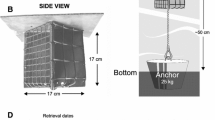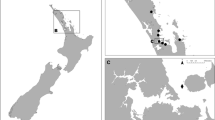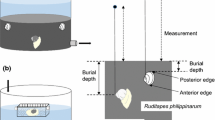Abstract
In 57 l-m2 samples within a meadow of Halodule wrightii in Bogue Sound, North Carolina, USA, densities of the clams Mercenaria mercenaria and Chione cancellata were positively associated with seagrass cover. Where seagrass was experimentally removed, marked individuals of both clam species exhibited high rates of mortality in fine sand sediments during two successive experiments spanning 13 months. In the unaltered (control) seagrass meadow, M. mercenaria density remained constant over 13 months and C. cancellata density declined at a slower rate than in the unvegetated plots. Seagrass provides these clams with a refuge from whelk (Busycon carica, B. contrarium, and B. canaliculatum) predation, the major cause of mortality and population decline in experimentally unvegetated plots. In 2 factorial field experiments in unvegetated substratum in which densities of M. mercenaria and C. cancellata were varied independently, first over 5 levels (0 X, 1/2X, 1 X, 2 X, 4 X) and subsequently over 4 levels (0 X, 1/4 X, 1 X, 4 X), there was no repeatable intra- or interspecific effect of density on percent survival, or on the rate of any mortality type. Whelk predation fell preferentially on larger size classes of both species, whereas factors which contribute to clam disappearance usually acted more intensely on smaller sizes. Experimental exclusion of large predators by caging demonstrated that even in unvegetated substratum survivorship of both clam species was high in the absence of whelks and other predators. Individuals of C. cancellata live closer to the sediment surface than those of M. mercenaria, which may explain why seagrass does not serve as effectively to protect them from whelk predation. The mechanism of whelk inhibition may depend upon sediment binding by the H. wrightii root mat, which produces a demonstrable decrease in the physical penetrability of surface sediments.
Similar content being viewed by others
Literature Cited
Au, S.: Vegetation and ecological processes on Shackleford Bank, North Carolina, 86 pp. U.S. National Park Service Scientific Monographs, no. 6 1974
Carriker, M. R.: Observations on the penetration of tightly closing bivalves by Busycon and other predators. Ecology 32, 73–83 (1951)
Carriker, M. R.: The role of physical and biological factors in the culture of Crassostrea and Mercenaria in a salt-water pond. Ecol. Monogr. 29, 219–266 (1959)
Connell, J. H.: A predator-prey system in the marine intertidal region. I. Balanus glandula and several predatory species of Thais. Ecol. Monogr. 40, 49–78 (1970)
Connell, J. H.: On the role of natural enemies in preventing competitive exclusion in some marine animals and in rain forest trees. Proc. Adv. Study Inst., Dyn. Numbers Pop. 1970, 298–312 (1971)
Dayton, P. K.: Competition, disturbance, and community organization: the provision and subsequent utilization of space in a rocky intertidal community. Ecol. Monogr. 41, 351–389 (1971)
Folk, R. L.: Petrology of sedimentary rocks. 2nd ed. 182 pp. Austin: Hemphill Publishing Company 1974
Gause, G. F.: The struggle for existence, 163 pp. New York: Hafner 1934
Ginsburg, R. M. and H. A. Lowenstam: The influence of marine bottom communities on the depositional environment of the sediments. J. Geol. 66, 310–318 (1958)
Holling, C. S.: The components of predation as revealed by a study of small-mammal predation of the European Pine Sawfly. Can. Ent. 91, 293–320 (1959)
Huffaker, C. B.: Experimental studies on predation: dispersion factors and predator-prey oscillations. Hilgardia 27, 343–383 (1958)
Landers, W. S.: Notes on the predation of the hard clam, Venus mercenaria, by the mud crab, Neopanope texana Ecology 35, 442 (1954)
Luckinbill, L. S.: Coexistence in laboratory populations of Paramecium aurelia and its predator Didinium nasutum. Ecology 54, 1320–1327 (1973)
Magalhaes, H.: An ecological study of snails of the genus Busycon at Beaufort, North Carolina Ecol. Monogr. 18, 377–409 (1948)
Menge, B. A.: Organization of the New England rocky intertidal community: role of predation, competition and environmental heterogeneity. Ecol. Monogr. 46, 355–393 (1976)
Menge, B. A. and J. Lubchenco: Community organization in temperate and tropical rocky intertidal habitats: prey refuges in relation to consumer pressure gradients. Ecol. Monogr. 51, (1981)
Murdoch, W. W. and A. Oaten: Predation and population stability. Adv. Ecol. Res. 12, 1–125 (1975)
Myers, A. C.: Sediment processing in a marine subtidal sandy bottom community: I. Physical aspects. J. mar. Res. 35, 609–632 (1977)
Orth, R. J.: The importance of sediment stability in seagrass communities. In: Ecology of marine benthos, pp 281–300. Ed. by B. C. Coull. Columbia: University of South Carolina Press 1977
Paine, R. T.: Ecological diversification in sympatric gastropods of the genus Busycon. Evol. 16, 515–523 (1962)
Paine, R. T.: Trophic relationships of 8 sympatric predatory gastropods. Ecology 44, 63–73 (1963)
Paine, R. T.: Intertidal community structure. Experimental studies on the relationship between a dominant competitor and its principal predator. Oecologia 15, 93–120 (1974)
Peterson, C. H.: The importance of predation and competition in organizing the intertidal epifaunal communities of Barnegat Inlet, New Jersey. Oecologia 39, 1–24 (1979a)
Peterson, C. H.: Predation, competitive exclusion, and diversity in the soft-sediment benthic communities of estuaries and lagoons. In: Ecological processes in coastal and marine systems, pp 233–264. Ed. by R. J. Livingston. New York: Plenum Press 1979b
Reise, K.: Predation pressure and community structure of an intertidal soft-bottom fauna. In: Biology of benthic organisms, pp 513–519. Ed. by B. F. Keegan, P. O. Ceidigh, P. J. S. Boaden, New York: Pergamon Press 1977
Reise, K.: Experiments on epibenthic predation in the Wadden Sea. Helgoländer wiss. Meeresunters. 31, 55–101 (1978)
Russ, G. R.: Effects of predation by fishes, competition, and structural complexity of the substratum on the establishment of a marine epifaunal community. J. exp. mar. Biol. Ecol. 42, 55–69 (1980)
Santos, S. L. and J. L. Simon: Distribution and abundance of the polychaetous annelids in a South Florida estuary. Bull. mar. Sci. 24, 669–689 (1974)
Snedecor, G. W. and W. G. Cochran: Statistical methods. Sixth ed. 593 pp. Ames: Iowa State University Press 1969
Stoner, A. W.: The role of seagrass biomass in the organization of benthic macrofaunal assemblages. Bull. mar. Sci. 30, 537–551 (1980)
Suchanek, T. H.: The ecology of Mytilus edulis L. in exposed rocky intertidal communities. J. exp. mar. Biol. Ecol. 31, 105–120 (1978)
Summerson, H. C.: The effects of predation on the marine benthic invertebrate community in and around a shallow subtidal seagrass bed, 118 pp. M.S. thesis, University of North Carolina, Chapel Hill 1980
Sutherland, J. P. and R. H. Karlson: Development and stability of the fouling community at Beaufort, North Carolina. Ecol. Monogr. 47, 425–446 (1977)
Thayer, G. W., S. M. Adams and M. W. LaCroix: Structural and functional aspects of a recently established Zostera marina community. In: Estuarine research, Vol. I. Chemistry, biology and the estuarine system, pp 518–540. Ed. by L. E. Cronin. New York: Academic Press 1975
Vermeij, G. J.: Biogeography and adaptation: Patterns of marine life, 332 pp. Cambridge: Harvard University Press 1978
Virnstein, R. W.: The importance of predation by crabs and fishes on benthic infauna in Chesapeake Bay. Ecology 58, 1199–1217 (1977)
Woodin, S. A.: Refuges, disturbance and community structure: a marine soft-bottom example. Ecology 59, 274–284 (1978)
Young, D. K., M. A. Buzas and M. W. Young: Species densities of macrobenthos associated with seagrasses: a field experimental study of predation. J. mar. Res. 34, 577–592 (1976)
Author information
Authors and Affiliations
Additional information
Communicated by J. M. Lawrence, Tampa
Rights and permissions
About this article
Cite this article
Peterson, C.H. Clam predation by whelks (Busycon spp.): Experimental tests of the importance of prey size, prey density, and seagrass cover. Mar. Biol. 66, 159–170 (1982). https://doi.org/10.1007/BF00397189
Accepted:
Issue Date:
DOI: https://doi.org/10.1007/BF00397189




